Can You Actually Learn A Language With Duolingo
Coke or Pepsi?
Superman or Batman?
And in the field of language learning, which comes out alee: Memrise or Duolingo?
These are some tough choices. But past the stop of this post, I'll settle the score.
Are you ready to swoop deep into each platform?
Contents
- Memrise
-
- What Is Memrise?
- The Memrise Interface
- Features
-
- Making Words and Phrases Memorable
- Mem Creation
- Chatbots and Grammabots
- Duolingo
-
- What Is Duolingo?
- The Duolingo Interface
- Features
-
- Edifice Memorable Sentences
- Gamified Language Learning
- Lively Forum Discussions
- Supplementary Duolingo Programs
- Memrise vs Duolingo: Who Wins?
-
- Memrise Pros:
- Memrise Cons:
- Duolingo Pros:
- Duolingo Cons:
Download: This weblog post is available equally a convenient and portable PDF that you lot tin can accept anywhere. Click here to go a re-create. (Download)
Memrise vs Duolingo: Which of These Popular Linguistic communication Learning Programs Is Right for You?
Memrise
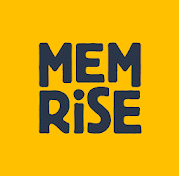
Available: iOS | Android
What Is Memrise?
What would you telephone call an app that is designed to aid y'all retrieve words?
Right—Memrise seems like the perfect name! It seems even more so when you realize that ane of the app's founders, Ed Cooke, is himself a retention grandmaster.
The other two masterminds behind the project are Ben Whately, who studied experimental psychology at Oxford:
And Greg Detre, a neuroscientist who studies the science of remembering things:
So, the very beginning thing yous demand to know nigh Memrise is that information technology was shepherded by guys who know what they are doing.
The next matter you need to know is that Memrise is a flashcard app/software… on steroids. These are non your grandmother's flashcards where she writes Castilian words on one side and their English language translations on the other. Memrise works with audio, video and text.
When you are looking at video clips of native speakers (and replaying them as often as you lot want), rifling through a bunch of audio samples and typing your answers on a keyboard, yous know you have come a long mode from grandma's ol' school flashcards.
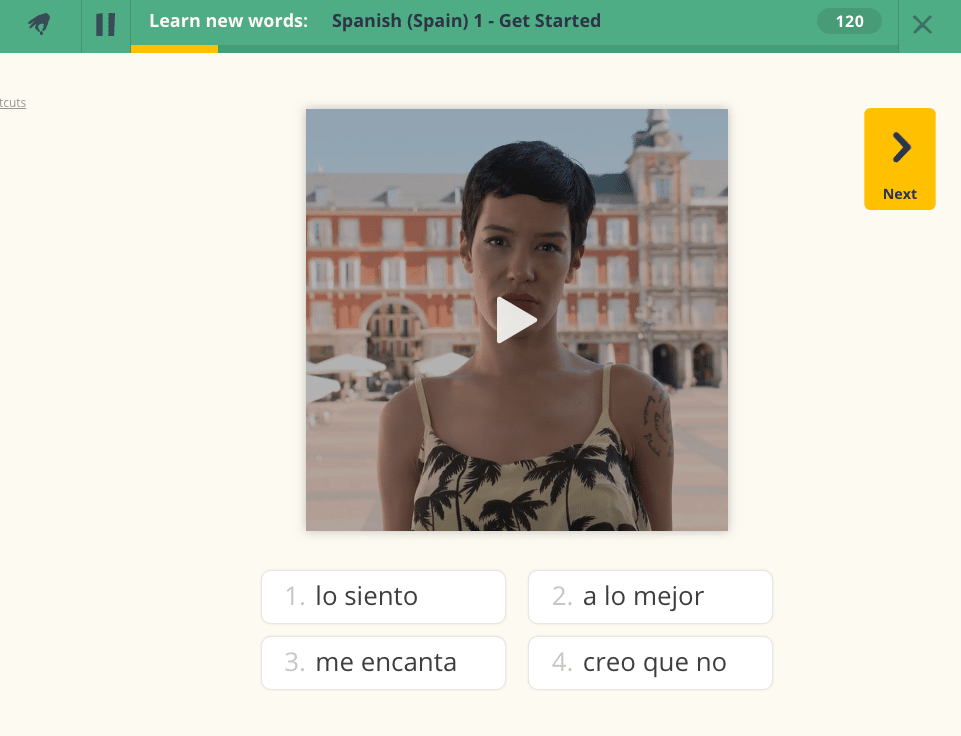
Memrise has accurate linguistic communication videos.
Memrise uses spaced repetition to assist users remember vocabulary. This means that difficult words show up in the exercises more oftentimes while those that you have already mastered are replaced by newer words. Memrise's algorithm "knows" the words you are struggling with because of instances when you lot make errors while the app is testing you on a particular discussion.
Say you lot are given an audio clip of the Spanish discussion "¡Hola!" ("Hello!"), and the app then asks you to pick its English language translation from the given choices. If you respond, "Cheers," for example, Memrise thinks, "Hmmmm, he got that one wrong. I better drill him more on this."
On the whole, Memrise is an first-class app for learning target language vocabulary. Information technology offers enough of languages, including Spanish, French, German, Chinese and Italian. Many of the app's anchor languages take been adult by the Memrise squad itself, but there are besides loads of other language courses that have been created past the users themselves including bottom studied languages such as Afrikaans, Ainu and Ojibwe.
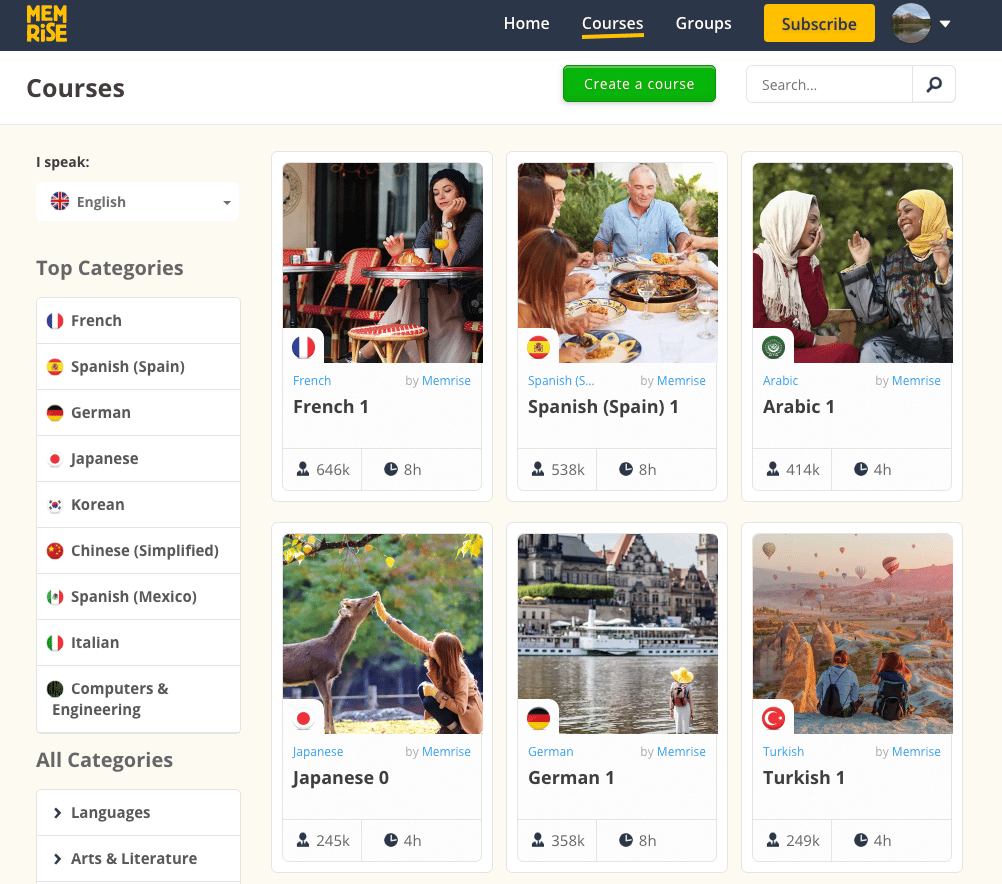
Just a small choice of the languages you tin can learn with Memrise.
The basic app is free, but a premium subscription can be affordably purchased one month at a time, annually or for a prepare fee every bit a lifetime subscription. This premium subscription allows learners to use the app offline as well every bit encounter detailed statistics most their progress.
The Memrise Interface
Memrise is available both as an app and every bit a website. The 2 interfaces are intuitive and sleek. You will not have also difficult a fourth dimension navigating them.
The app and website do vary a bit in terms of what is available and what can exist washed on each platform (and sometimes they do not sync perfectly).
With its "flashcard" technology, Memrise tin can practise more than teach you a language or help yous memorize new words. Information technology can basically help you memorize anything: trivia, capitals of the world, currencies, geography… you name information technology! It tin can as well teach yous the vocab for any subject: pattern, history, science, etc.
And, with this "flashcard" engineering, Memrise users can personalize decks. As a affair of fact, a lot of content on Memrise is user-generated, and this is i of the programme'due south strengths. Yous can learn so much just by clicking effectually and exploring their "Courses" department, and you tin can even create your own deck. The website reflects this and shows you the many things exterior of linguistic communication that y'all tin learn with Memrise. The app, on the other hand, seems to focus on language learning. (Information technology also prompts you to upgrade more often than most users would like.)
There were plans in late 2019 to move these user-created decks to a separate app called "Decks," just after user dissatisfaction on the decision, Memrise decided to leave all courses accessible as-is in one program. So you lot'll be able to go along making use of all the plan's functionalities, including user-created content, in i identify!
Below, we volition look more than closely into what is under the hood of this great learning tool.
Features
Making Words and Phrases Memorable
There are two main activities that can be done in the Memrise app. The start is "Acquire," and the second is "Review."
The "Learn" section is further divided into "Words and Phrases" and "Learn Grammer." These divisions are self-explanatory. You will probably spend about of your time initially in the "Words and Phrases" subsection, drilling new vocabulary, looking at videos, listening to audio clips and tapping correct answers for whatever given task.

Memrise teaches a bit of grammar.
The "Larn Grammar" subsection is where you get a trivial flake of grammar teaching. The operative phrase here is "a trivial bit." Do not expect too much handholding. You will get grammar highlights merely not the deep instruction that some students may be looking for. (But for the grammar concepts that they do tackle, expect the aforementioned appointment and finesse offered in the vocabulary section.)
The second main section of the app is the "Review" section, which is further divided into six different activities: "Classic Review," "Speed Review," "Hard Words," "Larn With Locals," "Pronunciation" and "Listening Skills." Some of these are premium features, then they require a subscription to be accessed and used.
You will have already encountered virtually of these activities when y'all initially learn words and phrases. Merely here, they are split into specific categories for farther focus. If you want to specifically review pronunciation, for example, head to "Pronunciation."
Here is a quick wait at what each of these subsections offers:
Archetype Review
This drills yous on the words you have already learned (no new words are introduced). You will again take on different tasks that allow you to appoint and piece of work with the vocabulary. You lot will practise back-and-along translations, type words into boxes, listen to audio clips and arrange phrases in their proper order. This is where your learning is cemented, and this characteristic is available for free to all users.
Speed Review
This is a run-through of all the words y'all have learned, but with the added pressure of being timed. For example, you lot will see an English word and iv options. Your job is to tap on the correct translation of the English word before the allotted fourth dimension expires.
The longer you lot take, the more your screen will be taken over by the colour ruddy. The speed review is an of import gauge of how well you recall learned words under pressure, which reflects how deeply embedded the vocab is in your memory. This feature is available for costless to all users equally well.
Difficult Words
A session here will requite you the hazard to really drill those words marked by the app as "difficult." Maybe you made multiple mistakes during the learning session. Those relevant items are added to the "Difficult Words" department. Another way of populating this subsection is past marking the words yourself.
If you encounter a word which, at first sight, sends a chill upwards your spine, you can preemptively marking it equally difficult and information technology will be added to this section. This will afford you more opportunities to practice the word. Keep in listen, still, that the "Difficult Words" feature is only available to paying Memrise users.
Listening Skills
This has everything to practise with sounds and how y'all are able to make out the dissimilar words of the target language. Some words in languages like French take pronunciations that are quite dissimilar from how the words are spelled. This subsection lets you lot listen to audio clips and hone your ears to the tonal menses of your target linguistic communication, but users must subscribe to a premium membership to use this characteristic.
Pronunciation
Just considering you lot have consistently tapped on correct translations does non mean you know how to really say a word. This section prompts you lot to pronounce the words and phrases you have learned.
Afterwards paying for a premium Memrise membership, speak upwards on your phone'southward mic and say the give-and-take or phrase but like the native speaker does. Memrise's technology volition "heed" and determine if you have washed it reasonably well. If not, practice not worry, yous can ever try again.
Acquire With Locals
At present, this is where the platform actually shines—even the spokespeople for alternative Memrise programs would probably agree.
Here, you lot work with brusque video clips featuring native speakers to learn the most basic expressions. The advantage here is that you are not just seeing pictures or hearing audio. You lot are actually seeing brusque clips of native speakers demonstrating how words and phrases sound. So, you take the benefit of both audio and moving visuals working together to brand the vocabulary actually stick.
This is where the target linguistic communication comes alive through you lot observing facial expressions. For case, you see a grinning when a native French speaker says, "Merci!" ("Thanks!") or pursed lips when she says, "Non" ("No").
In the "Larn with Locals" subsection, you really begin to understand the communicative aspect of the language. This feature, notwithstanding, is only bachelor to premium members.
Keep in mind, however, that fifty-fifty though you lot're "learning with locals," this is non the same equally practicing with native speakers. You are not actually having a conversation, and even though at that place is native audio, the clips are rather short. In fact, I would argue that the clips are too short even to create a worthwhile immersion environment, which is one of the best ways to larn.
Contrast this, for instance, with a language learning plan like FluentU.
FluentU uses accurate videos—similar music videos, news clips and inspiring talks— to immerse yous in native content and teach you how real conversations sound in context.

Mem Creation
With Memrise, you lot tin personalize each flashcard by creating a "mem."
"Mems" are mnemonic devices in the form of text or pictures that assist make the words and their translations memorable to you lot.
For example, for the Spanish word "Hola," yous might add together a flick of a bearded man holding a donut in 1 hand and waving "Hi!" with the other. So, in your head, y'all are thinking, "There is a hole in the donut and it could be the letter of the alphabet O in hola. And, the guy holding information technology is waving hi or hi. Perfect!"
So, for yous, that picture makes "hola" stick in your caput. Y'all decide to make information technology a "mem" and then that each time "hola" is presented, the donut guy also appears.
How are you going to set that upwardly?
Well, making i is really easy. (Annotation that it is much better to employ the web version of Memrise for this.)

Memrise uses "mems" to make vocab learning more memorable.
As the words are initially presented to y'all during the learning phase, there is a "Assist me learn this" button. This is your first step to mem creation. Click on it and you will get to run across if other people accept already created a mem for the word or phrase. Some words may already accept several mems created past other users, and you might decide to use what is already at that place. Or, you tin can add your own mem by clicking on "+ Add together a mem."
You lot will then be given the chance to upload the picture that you want and even write a caption or accompanying text. Anything goes—y'all can cull any picture or write any text. Think of something that is going to make the word stick for you.
"Mems" are highly personal. Since you make them yourself, they are meaningful and memorable to y'all. Just, that does non mean you lot cannot share them. Other users can as well do good from the mems you brand.
Some learners forgo this feature and only make do with the standard Memrise presentation, thinking it takes too much time to observe that perfect picture show or write that ideal explanation. I think this is a large mistake. In gild for something to exist memorable, you need to wrestle with it. Yous demand to invest fourth dimension and effort into information technology.
The very deed of creating a mem—searching for the picture and thinking of a good caption—is a retentivity-enhancing process. Aye, information technology is time-consuming, merely it will besides embed the word in your memory. As a result, y'all will exist much more than likely to remember the vocab.
In other words, your encephalon becomes actively involved in the learning process instead of just passively memorizing things.
Chatbots and Grammabots
In addition to the four premium review features, Memrise Pro also comes with two additional "techie" features: the chatbot and grammabot functions.
Chatbot
If your imagination works simply fine, you might enjoy the journey this feature offers. The goal here is to let you practice the target language without the stress of embarrassing yourself in forepart of a existent person.
The chatbot transports you to the land where your target language is spoken. He then lets you "collaborate" with the locals.
What actually happens is that yous volition be placed in an imaginary situation, say, a "Run across & Greet," with a friendly local (a bot). You will exist given options of what you lot can say in a standard back-and-forth conversation. For example, you lot can pursue an interaction by saying, "¡Hola!" back to a stranger who is trying to get to know you, or yous can click "Evict" to extricate yourself from the scenario.
This feature resembles a cull-your-own-adventure game in a chat environment, and while it doesn't allow for the most spontaneous conversation, information technology definitely doesn't hurt. It is simply available with the later levels of major languages, though.
Grammabot
This is a chatbot that focuses on grammer and parts of speech.
This is essentially the "Learn Grammar" section only in conversation form. The grammabot will send you messages that explain different grammer concepts. It will then examination your comprehension of the lesson. For example, it will ask you to adjust words in the correct club.
These two features obviously offer a number of possibilities for improvement. All the same, more than content needs to be adult and then that users do non cycle through the aforementioned lessons over and once more.
You lot now know the ins and outs of Memrise.
Next, we will head over to the greenish corner and expect into the linguistic communication learning platform Duolingo.
Duolingo
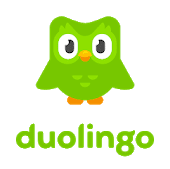
Available: iOS | Android
What Is Duolingo?
Offering 35 language courses for English speakers as of June 2020, Duolingo is a behemoth of a learning platform. The app lone has already been downloaded over 100 one thousand thousand times. You lot cannot get into language learning without coming into contact with, or at to the lowest degree reading or hearing nearly, Duolingo. (The discussions from its forums alone can often crop upwards in your Google searches.)
Duolingo is the brainchild of Luis von Ahn and Severin Hacker. The old invented the "Captcha":
And the latter is a multi-awarded entrepreneur and vivid Swiss computer scientist:
Duolingo is a language learning app and platform that shares a lot of the features nosotros take already talked about with Memrise. That is why these 2 programs have naturally been pitted against each other. Duolingo offers linguistic communication exercises and drills that railroad train users in both vocabulary and grammar. Information technology engages learners through tasks like translating betwixt languages, identifying pictures, listening to audio and typing on a keyboard.
Duolingo bills itself as "the new way to larn a language," incorporating game elements into its standard performance.
The first "F" of the Duolingo philosophy is that language learning should be "fun." Later we will talk nearly exactly how Duolingo injects this into every lesson.
The second "F" is that it is "costless." (Isn't everything though, these days?)
Duolingo earns its go on some other style, so you become a ton of material without ever spending a dime. Non much is subconscious behind a payment wall—no new content or intrinsically avant-garde features are offered.
You fifty-fifty get the sense that Duolingo is not actually pushing very hard for Duolingo Plus, its premium subscription option, which is quite an affordable monthly subscription fee. Other than getting rid of ads, Duolingo'south premium program doesn't offering much outside of an offline mode and assuasive users to have unlimited "Hearts" (lives, so to speak, when trying to exam out of a level).
The Duolingo Interface
Like Memrise, Duolingo is also available as a website and equally an app.
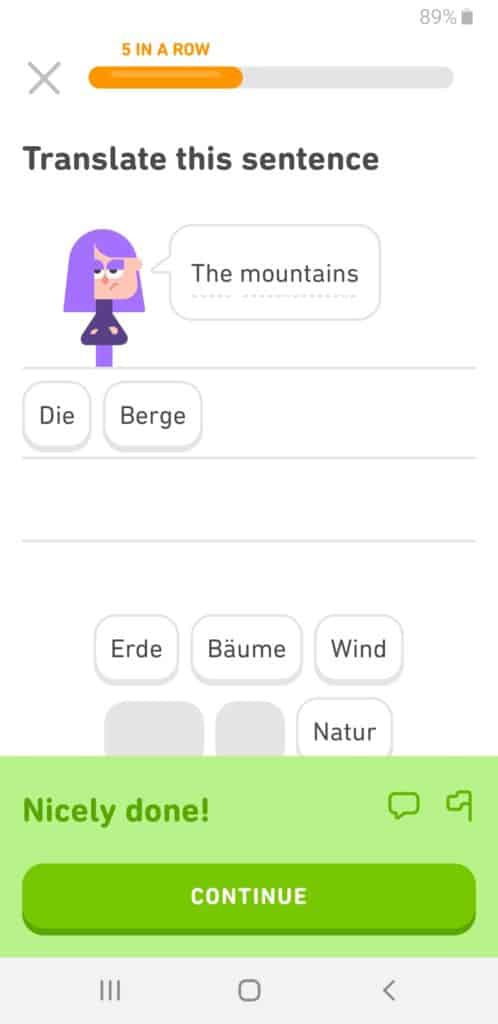
Duolingo has a convenient, game-based interface.
Whether you lot are working on your computer or going mobile, you become to experience the same instinctive interface. The layout is like shooting fish in a barrel to navigate and you should non have any issues getting where you desire to become. But, just similar with Memrise, the website and app do not always perfectly sync. (This is what naturally happens when tech teams are tinkering behind the scenes and trying to make the product a little better.)
In terms of fonts, colors and graphics, Duolingo is a fiddling bit more playful than Memrise, as it features drawing-like images. And, of course, do non forget Duo, the lovable greenish owl who is the face up of Duolingo. This cutie peeks out from your screen every once in a while to cheer you on.
There are likewise enough of dings and dongs, sounds that tell you each fourth dimension you go a correct or incorrect answer. The app is pretty vocal, significant that introduced words and phrases oft come with an audio component—which you would do well to repeat afterwards. There are courses, however, that are missing audio such as Swahili and fictional languages such as High Valyrian from the famed "Game of Thrones" Goggle box series.
Then, for best results, even if you are on your phone and using headphones, it is improve to be somewhere individual where yous tin can say the words aloud. Duolingo would not mean very much if you merely primary tapping on the right reply without ever opening your mouth.
That said, let'due south swoop a little deeper into Duolingo and meet what information technology brings to the linguistic communication learning table.
Features
Building Memorable Sentences
As mentioned earlier, many of the mechanisms for learning that nosotros accept talked near with Memrise as well exist with Duolingo.
Your language form is one long learning "tree," which is divided into numerous mini-sections that get from the accented basics to an intermediate level. Each mini-section has an over-arching theme, like sports, recipes, couples, etc.
There is a set sequence to these sections, and each one is locked (greyed out) until you complete the previous sections satisfactorily.
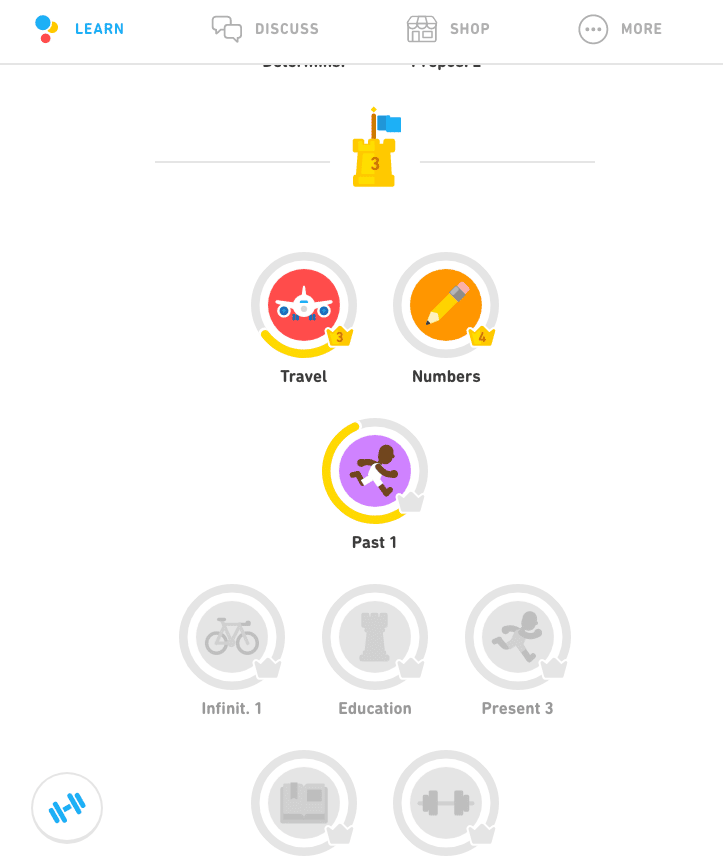
Make your way through the Duolingo learning tree.
Duolingo gets you to perform different simple tasks, similar matching words and their translations, matching images with their foreign language names, saying a word or phrase presented on the screen, listening to sound or typing on the keyboard—practically the very same blazon of exercises in the "Words and Phrases" section of Memrise.
They drill the vocab items over and over, from English to the target language (and vice versa!) so that what y'all are learning becomes firmly embedded in your long-term retentiveness.
Duolingo starts with vocab and slowly builds words into phrases until you get to total sentences. There is a seamless transition between old words and new ones because they are presented side-by-side. The mastered words are slowly phased out while the new ones are gradually worked in. Earlier y'all know it, you have already picked up several new words in your new language past simply working on pint-sized tasks. Each mini-section also comes with a "Tips" page: this is essentially a lesson tutorial that briefly explain grammar and vocabulary usage notes related to the lesson.
Absolutely, Duolingo's sentence examples do accept a lot of room to improve. Sometimes they can be funny, sometimes fifty-fifty downright weird (there's even a whole subreddit about its sometimes ridiculous example sentences). Users might find that the sentences they are working on are non especially helpful in actual conversations.
Gamified Language Learning
Duolingo says it simply takes v minutes a day to learn the language. Just, you tin bet your lesser dollar that they want you in the Duolingo ecosystem for the long haul.
Look at how the whole feel is set: The platform has poured gaming elements into every lesson, making it fun and motivating. At that place are also game elements in Memrise, but it just seems that Duolingo has the loftier ground on this i.
Each move you make in Duolingo is recorded. Each correct answer has a respective number of "Experience Points" (XPs), and the longer you piece of work on tasks, the more XPs you earn.
Reaching a certain number of XPs leads to "lingots." They are the virtual currency of the platform that yous tin can use for things like ownership bonus skills and power-ups. Y'all tin fifty-fifty give lingots to other users and spread goodwill. Yous tin also use lingots at the virtual store to buy different costumes for Duo, the mascot.
In my opinion, Duolingo has non actually tapped the total potential of their lingot organisation. If they add more uses for these, it could potentially exist a game-changer.
Some other metric to watch out for is your "Streak." This refers to the number of days that you accept met your daily XP goals. (You can set your goals in the "Settings" section.)

Level up with Duolingo.
Additionally, Duolingo uses "levels" to determine the complication of the textile and the mastery you have of a topic. After completing the lessons each mini-section a first fourth dimension, the next mini-section is unlocked. Y'all can return to previously-completed mini-sections, even so, and level them upwardly, each level making the cloth harder and asking more and more from the learner.
Afterwards v "level ups," the mini-section becomes gilded, significant you accept mastered the skill. These human action as progress bars, and the golden status eventually goes away (appearing "cleaved") the longer you exercise not practice.
While this is a bang-up mode to review, it is a little bit of a time-waster to take to review an entire lesson if y'all really merely forget a couple of words. Duolingo could definitely benefit from a Spaced Repetition System, like other language learning programs such every bit FluentU.
After clicking on a word in a transcription, FluentU users can turn this discussion and its accompanying audio into a flashcard and add it to a customized deck.
Moving forward, learners never have to approximate which words need review: FluentU does that for them with progress confined nether the "Fluency" cavalcade. A full progress bar ways the word is learned, and every flashcard revision increases a word'southward progress bar.
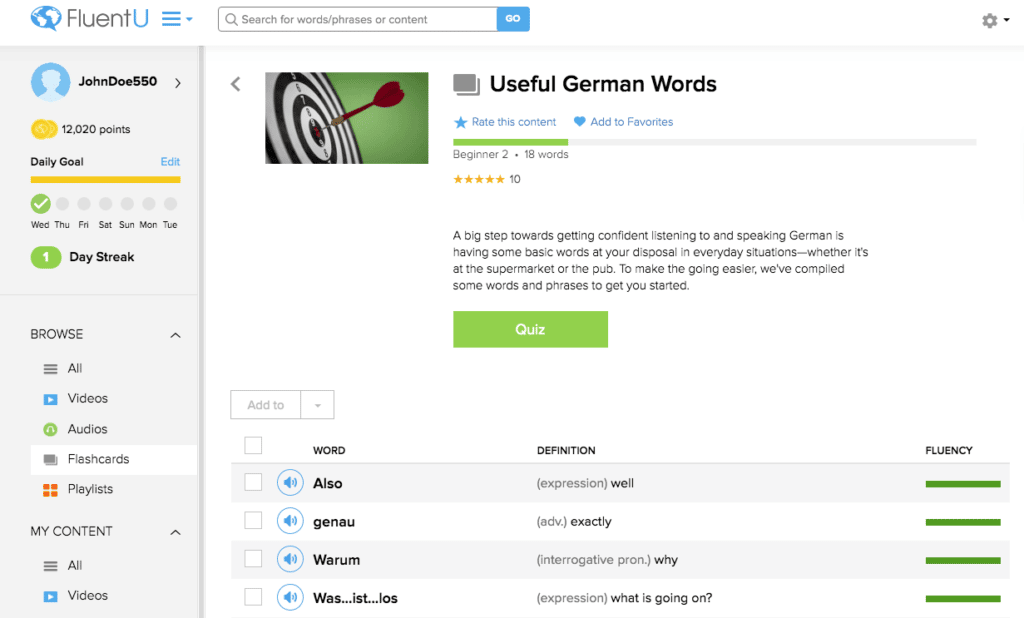
Learn new vocab with FluentU's multimedia flashcards.
Duolingo also has leaderboards that tell y'all your position vis-à-vis others.
I remember the near important metric is the "Streaks" number, the number of consecutive days you have worked on Duolingo. Language learning needs consistency. If you lot work at it erratically, you will never reach fluency. So, yous amend make those "Streaks" as high as yous possibly can.
Lively Forum Discussions
Ane awesome thing near Duolingo is that yous can post a annotate at practically whatsoever point in your session. Every time you see the message icon, it ways there is already a give-and-take happening almost that item question. These threads are fertile with insights from native speakers and swain language learners.
Duolingo has some of the about active language forums around. They are wellsprings of insight and information. That is what happens when you have around 300 million users worldwide. There are bound to be interesting and engaging discussions all effectually.
While Memrise makes the platform social by making "mems" shareable to others, Duolingo tin can boast of these lively conversations going on between learners who are sharing language resources, request written report advice or simply engaging in a random conversation betwixt kindred spirits. You volition never feel alone.
Check out this even deeper expect at Duolingo and whether information technology works or not.
Supplementary Duolingo Programs
In improver to the base Duolingo trees, some of the more popular languages have boosted features that can exist helpful in learning.
Firstly, Duolingo also has a "Stories" feature, which tin can easily rival Memrise's chatbot function. For English language users, Duolingo "Stories" are only available for French, German, Spanish and Portuguese. The stories too happen in a chat environment. You are taken to a specific scenario where you need to answer comprehension questions in club to move the story along. For case, in a French story betwixt a married man and wife, you might be asked to choose the correct discussion that you hear or that works in the judgement.
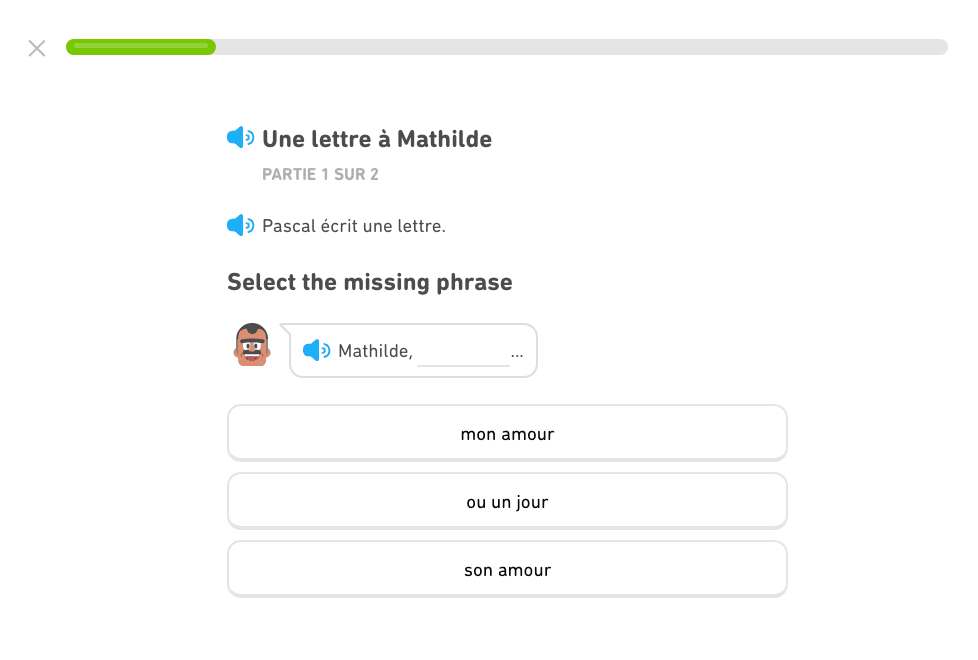
Duolingo gets y'all involved with interactive stories.
Farther, Duolingo has adult podcasts for two of its most popular languages, Spanish and French. These are a great way to larn these languages on the go.
Perchance the characteristic that nearly rivals Memrise, withal, is Tiny Cards. Like Memrise, Tiny Cards uses flashcards and a Spaced Repetition System to teach vocabulary. In that location are decks to supplement all of the Duolingo tree-structured courses also as Duolingo Stories and the podcasts. In that location is even an pick for learners to create their own flashcards likewise as loads of user-generated decks with accompanying audio.
If you're studying a language such as Spanish, all four of these features—the base "tree," Duolingo Stories, Spanish Tiny Cards decks and the Spanish podcast—would create a very well-rounded learning program.
Memrise vs Duolingo: Who Wins?
Then, after all has been said and done, which one is the better platform: Memrise or Duolingo?
Memrise Pros:
- Gratuitous!
- User-friendly interface.
- Elegant vocabulary-learning tool.
- Ability to incorporate user-generated content.
- Video clips featuring native speakers make the language come up alive.
Memrise Cons:
- Also much push for the upgrade & arguably lackluster premium features to match.
- Does not take many grammer lessons or much content for advanced learners.
- Express native sound and speaking practice.
Duolingo Pros:
- Gratis!
- User-friendly interface.
- Tin can teach you grammar and sentence structures.
- Gamified learning.
- Active language forums.
- Lots of native sound and supplementary materials (only for most popular languages).
Duolingo Cons:
- Needs more than relevant sentence examples.
- Does not take much content for avant-garde learners.
- Limited speaking do.
Then, who wins!?
Clearly there is only one winner… and that is you, the linguistic communication learner!
You lot accept access to ii (three, if you count FluentU!) of the almost technologically-advanced language learning systems adult past folks who love what they are doing and who have learners' interests at middle.
For example, if y'all want to learn vocab, possibly you can showtime with Memrise to get the ball rolling, and when you want to graduate to sentence structure and grammar, you lot can opt for Duolingo. (You can have Duolingo'southward placement exam and skip to the later lessons.)
These platforms are certainly non mutually sectional. They nicely complement each other.
I salute all of your efforts and wish you the very best on your journey to learn a new language.
Good luck!
Download: This blog post is bachelor as a convenient and portable PDF that you can take anywhere. Click here to get a copy. (Download)
Source: https://www.fluentu.com/blog/memrise-vs-duolingo/
Posted by: babinforintolue.blogspot.com


0 Response to "Can You Actually Learn A Language With Duolingo"
Post a Comment